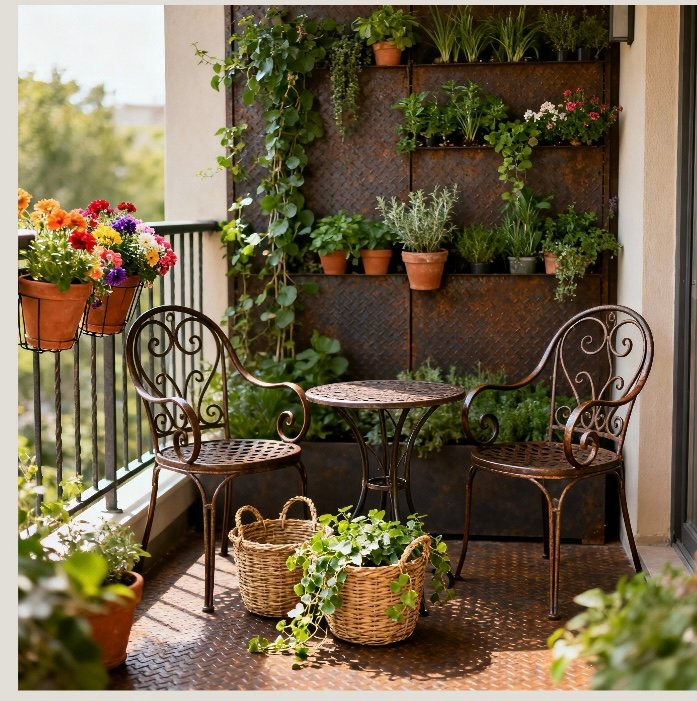Apartment Living DIY Balcony Green Roof: A Step-by-Step Guide

You don’t need to own a building or have deep pockets to enjoy the benefits of a garden. With a few smart choices, you can turn your balcony (or safe flat rooftop area) into a mini-green garden using containers. Think of it as a portable patch of meadow that feeds pollinators and gives you fresh herbs and veggies.
Supplies You’ll Need
- Lightweight containers (fabric grow bags, recycled plastic pots, or railing planters)
- Saucers or trays to protect balcony surfaces from water damage
- Potting mix (not garden soil—too heavy)
- Drainage material (perlite, pumice, or lightweight gravel for the bottom of containers)
- Plants (sedum, creeping thyme, oregano, lettuces, dwarf peppers, strawberries, or other shallow-rooted choices)
- Optional: vertical planter pockets, trellis for vines, drip irrigation kit for hot summers
Step-by-Step Setup
Step 1: Plan Your Layout
Measure your balcony or flat area and decide how much space you want to dedicate. Keep in mind weight distribution. Spread containers out rather than clustering everything in one corner.
Step 2: Choose Your Containers
Go for fabric grow bags or fibreglass pots to keep the weight down. Rail planters and hanging pockets are great for renters who don’t want to clutter the walking space.
Step 3: Add Drainage Layers
Line the bottom of each container with 1–2 inches of lightweight gravel or pumice. This prevents soggy roots and mimics the drainage layer on professional green roofs.
Step 4: Fill with Potting Mix
Use a lightweight, peat-free potting mix. Mix in perlite or compost for aeration and nutrients.
Step 5: Plant Selection & Planting
For a “green roof” feel, use low-growing, drought-tolerant plants like sedum, thyme, and oregano. For edible bonuses, add lettuces, herbs, strawberries, or dwarf vegetables. Tuck in a few pollinator-friendly flowers like calendula, alyssum, or nasturtiums.
Step 6: Water & Mulch
Water thoroughly after planting. Add a thin layer of straw, bark mulch, or even coconut coir to retain moisture.
Step 7: Maintain
Water regularly (especially in summer). Snip herbs and greens often—harvesting keeps them growing. Refresh soil and replant seasonally for year-round greenery.
Apartment Living – DIY Balcony Green Roof: A Step-by-Step Guide Optional Upgrade: Vertical Garden
Add a living wall panel or pocket garden against one balcony wall. This brings more greenery without adding floor weight.
Adding a Vertical Garden
If your balcony is more wall than floor, or if you’d rather keep space open for chairs and a table, a vertical garden is a smart add-on to your mini green roof. Instead of spreading out, you grow up.
Why Go Vertical?
- Vertical gardens make balconies greener without crowding your feet—and they pair beautifully with container “roof” setups for a fuller, more functional garden.
- Saves floor space on small balconies.
- Keeps plants within easy reach for watering and harvesting.
- Creates a lush, living privacy screen.
- Can be moved with you if you’re renting.
Vertical Options for Renters
- Hanging pockets: Fabric or felt panels with pockets for herbs and flowers. Easy to hang on hooks or railing.
- Trellis with pots: Lightweight pots clipped to a wire grid or trellis. Perfect for strawberries, beans, or small tomatoes.
- Stacked planters: Tiered planters or stackable pots that let you grow multiple plants in a small footprint.
- DIY pallet wall: Upcycle a wooden pallet by adding landscape fabric and filling with soil—instant wall garden (make sure it’s well supported and doesn’t overload your balcony).
Best Plants for Vertical Gardens
- Herbs: basil, thyme, oregano, parsley, mint (keep in separate pocket).
- Greens: lettuces, spinach, arugula.
- Flowers: nasturtiums, calendula, alyssum (great for pollinators).
- Climbers: peas or dwarf beans on a trellis.
Care Tips
- Water from the tap. Gravity helps feed lower plants.
- Use a lightweight potting mix to keep things easy on the structure.
- Rotate or replant pockets seasonally for a continuous harvest.
See: Green roof projects
